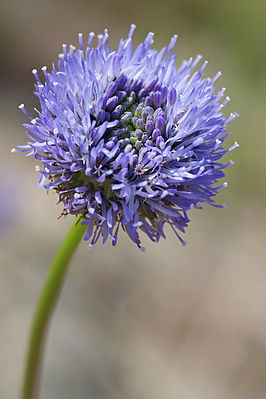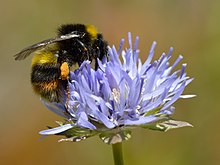Mountain sand bells
| Mountain sand bells | ||||||||||||
|---|---|---|---|---|---|---|---|---|---|---|---|---|

Mountain sand bells ( Jasione montana ), inflorescence with flowers in different stages of development |
||||||||||||
| Systematics | ||||||||||||
|
||||||||||||
| Scientific name | ||||||||||||
| Jasione montana | ||||||||||||
| L. |
The Jasione Montana ( Jasione montana ), also mountain sand Rapunzel , sand knobs , Mountain Elke or sheep Skabiose called, is a plant of the genus jasione ( Jasione ) in the family of Bellflower Family (Campanulaceae).
In order to draw attention to this rare species and its endangered habitat, the mountain sandbell was chosen as flower of the year in 1990 . This species is endangered because of the high nutrient input into poor fringing biotopes, which are themselves in decline.
description
Vegetative characteristics
The mountain sandbell grows as an annual, overwintering or biennial herbaceous plant that reaches heights of 20 to 60, rarely up to 80 cm. The root system extends up to 1 meter deep. No runners are formed. The branched stem can be prostrate or upright. The leaves, which are only found in the lower part of the stem, are elongated to lanceolate and have a wavy, curly edge.
Generative characteristics
The cup-shaped inflorescence standing on a long inflorescence stem reaches a diameter of 1.5 to 2.5 centimeters. The twelve or more imbricated bracts are oblong to ovate with pointed apexes and usually shorter than the flower. The hermaphrodite flowers are five-fold with a double flower envelope . The five sepals are shorter than the petals and durable. The five light blue, rarely white petals are fused with tubes at the base with five linear corolla lobes, which are straight before opening. There are five stamens with blue, awl-shaped stamens that do not protrude above the crown. The stylus protrudes from the crown and ends in a two-lobed scar. The flowering period extends from June to August.
Small, protruding, rounded and pentagonal capsule fruits with two pores popping open at the tip are formed, which are crowned with claws by the durable sepals. The almost egg-shaped seeds are small.
The number of chromosomes is 2n = 12 for the subspecies subsp. montana and 2n = 14 for the subsp. litoralis .
ecology
The mountain sand bell is a semi-rosette plant with roots up to 1 meter deep ( sand plant ). The flowers are pre-male cup flowers, very similar to those of the daisy family. The single flowers are split to the bottom. They open from the bottom up. The anthers are fused at the base. They block the way to the nectar and serve as a layer of juice. The pollen is emptied onto the stylus brush in the flower bud. Later the anthers expand, the stylus elongates greatly, and the bilobed stigma unfolds. Pollinators are many two-winged birds , bees (up to 100 species), butterflies and beetles ; Self-pollination does not occur.
The small size of the leaves and their coarse hairs are adaptations to temporary drought. The seeds are scattered by animals and the wind. Maturing seeds are suitable for studying embryonic development.
Occurrence
The sand bells occur in mountainous locations as well as in the gray dunes of the North and Baltic Sea coasts. It grows preferentially on dry, sandy grasslands or in rocky areas with little lime, but also as a deep-rooted pioneer plant on fallow land . They can be found on barren and lime-free sandy soils, on dry grassland, dunes and rock heads. The distribution area includes Europe and northwestern Africa.
In Austria this species became extinct in Vienna , otherwise it is scattered or rarely in all federal states.
According to Ellenberg , the mountain sandbell is a half-light plant, a dry pointer, an acid pointer, and an order character of the rock gravel and rock band societies (Sedo-Scleranthetalia).
Systematics
Jasione montana was 1753 by Linnaeus in Species Plantarum , 2, pp 928-929, first published . It is the type species of the genus Jasione .
Jasione montana is quite rich in forms; it is divided into the following subspecies:
- Jasione montana L. subsp. montana : This is the widespread clan with an average higher and ascending habit. It occurs in Europe and northwestern Africa.
- Jasione montana subsp. litoralis Fr .: This clan is rarer. It is smaller, grows rather prostrate and occurs in the gray dunes of the North and Baltic Sea coasts. Some authors do not consider this to be an independent subspecies and see it as a synonym for Jasione montana subsp. montana on.
- Jasione montana subsp. cornuta (ball) Greuter & Burdet : It occurs in Morocco.
- Jasione montana subsp. paivae Horjales & Rubido : This subspecies was first described in 2011 and occurs in Spain.
swell
- Albert Dietrich, Friedrich Klotzsch: Flora regni Borussici: Flora of the Kingdom of Prussia or illustration and description of the plants growing wild in Prussia , Volume 3. Verlag von Ludwig Ochmigke, 1835. Google Book Online. 211: Jasione montana
- The mountain sand rapunzel (Jasione montana) - adapted to barren soils by the Baden-Württemberg Ministry for the Environment, Nature Conservation and Transport.
- Mountain sand bells. In: FloraWeb.de.
Individual evidence
- ↑ a b Erich Oberdorfer : Plant-sociological excursion flora for Germany and neighboring areas . With the collaboration of Angelika Schwabe and Theo Müller. 8th, heavily revised and expanded edition. Eugen Ulmer, Stuttgart (Hohenheim) 2001, ISBN 3-8001-3131-5 , pp. 898 .
- ↑ First publication scanned at biodiversitylibrary.org.
- ↑ a b c d Rafaël Govaerts (Ed.): Jasione - data sheet at World Checklist of Selected Plant Families of the Board of Trustees of the Royal Botanic Gardens, Kew. Last accessed on April 8, 2016.
Web links
- Jasione montana L., Mountain Jasione. In: FloraWeb.de.
- Mountain sand bells . In: BiolFlor, the database of biological-ecological characteristics of the flora of Germany.
- Profile and distribution map for Bavaria . In: Botanical Information Hub of Bavaria .
- Jasione montana L. In: Info Flora , the national data and information center for Swiss flora . Retrieved April 8, 2016.
- Distribution in the northern hemisphere
- Thomas Meyer: Data sheet with identification key and photos at Flora-de: Flora von Deutschland (old name of the website: Flowers in Swabia )
- photos





